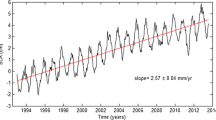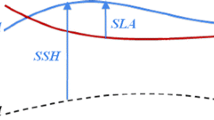Abstract
Rising sea level is of great significance to coastal societies; predicting sea level extent in coastal regions is critical. When carrying out predictions, the subsequences obtained using decomposition methods may exhibit a certain regularity and therefore can provide multidimensional information that can be used to improve prediction models. Traditional decomposition methods such as seasonal and trend decomposition using Loess (STL) focus mostly on the fluctuating trend of time series and ignore its impact on prediction. Methods in the signal decomposition domain, such as variational mode decomposition (VMD), have no physical significance. In response to the above problems, a new decomposition method for sea level anomaly time series prediction (DMSLAP) is proposed. With this method, the trend term in a time series can be isolated and the effects of abnormal sea level change behaviors can be attenuated. We decompose multiperiod characteristics using this method while maintaining the smoothness of the analyzed series. Satellite altimetry data from 1993 to 2020 are used in experiments conducted in the study area. The results are then compared with predictions obtained using existing decomposition methods such as the STL and VMD methods and time varying filtering based on empirical mode decomposition (TVF-EMD). The performance of DMSLAP combined with a prediction method resulted in optimal sea level anomaly (SLA) predictions, with a minimum root mean square error (RMSE) of 1.40 cm and a maximum determination coefficient (R2) of 0.93 during 2020. The DMSLAP method was more accurate when predicting 1-year data and 3-year data. The TVF-EMD and DMSLAP methods had comparable accuracies, and the periodic term decomposed by the DMSLAP method was more in line with the actual law than that derived using the TVF-EMD method. Thus, DMSLAP can decompose SLA time series better than existing methods and is an effective tool for obtaining short-term SLA prediction.
Similar content being viewed by others
Data Availability Statement
Publicly available datasets were analyzed in this study. The satellites altimetry data can be found here: AVISO website (https://www.aviso.altimetry.fr/).
References
Ataee P, Yazdani A, Setarehdan S K et al. 2007. Genetic algorithm for selection of best feature and window length for a discriminate pre-seizure and normal state classification. In: 5th International Symposium on Image and Signal Processing and Analysis. IEEE, Istanbul, Turkey. p.107–112.
Bignalet-cazalet F, Picot N, Desai S et al. 2021. Jason-3 products handbook. https://www.aviso.altimetry.fr/fileadmin/documents/data/tools/hdbk_j3.pdf. Accessed on 2023-02-16.
Blanc F, Borra M, Boudou P et al. 1996. AVISO user handbook: merged Topex/Poseidon products. https://www.aviso.altimetry.fr/fileadmin/documents/data/tools/hdbk_tp_gdrm.pdf. Accessed on 2019-03-07.
Box G E P, Jenkins G M. 1976. Time Series Analysis: Forecasting and Control. Holden-Day, San Francisco. 592p.
Bronner E, Picot N, Desjomqueres J D et al. 2016. Jason-1 products handbook. https://www.aviso.altimetry.fr/fileadmin/documents/data/tools/hdbk_j1_gdr.pdf. Accessed on 2019-03-07.
Broomhead D S, King G P. 1986. Extracting qualitative dynamics from experimental data. Physica D: Nonlinear Phenomena, 20(2–3): 217–236, https://doi.org/10.1016/0167-2789(86)90031-X.
Cazenave A, Palanisamy H, Ablain M. 2018. Contemporary sea level changes from satellite altimetry: what have we learned? What are the new challenges? Advances in Space Research, 62(7): 1639–1653, https://doi.org/10.1016/j.asr.2018.07.017.
Chen A P, Groenewold N. 2010. Reducing regional disparities in China: an evaluation of alternative policies. Journal of Comparative Economics, 38(2): 189–198, https://doi.org/10.1016/j.jce.2009.12.003.
Chen Q, van Damb T, Sneeuw N et al. 2013. Singular spectrum analysis for modeling seasonal signals from GPS time series. Journal of Geodynamics, 72: 25–35, https://doi.org/10.1016/j.jog.2013.05.005.
Chouksey M, Jha R K. 2021. A multiverse optimization based colour image segmentation using variational mode decomposition. Expert Systems with Applications, 171: 114587, https://doi.org/10.1016/j.eswa.2021.114587.
Church J A, Clark P U, Cazenave A et al. 2013. Sea level change. In: Stocker T F, Qin D, Plattner G K et al eds. Climate Change 2013: The Physical Science Basis. Contribution of Working Group I to the Fifth Assessment Report of the Intergovernmental Panel on Climate Change. Cambridge University Press, Cambridge. p.1137–1216.
Cleveland R B, Cleveland W S, McRae J E et al. 1990. STL: a seasonal-trend decomposition procedure based on Loess. Journal of Official Statistics, 6(1): 3–33.
Cleveland W S. 1979. Robust locally weighted regression and smoothing scatterplots. Journal of the American Statistical Association, 74(368): 829–836, https://doi.org/10.1080/01621459.1979.10481038.
Dagum E B, Bianconcini S. 2016. Seasonal Adjustment Methods and Real Time Trend-Cycle Estimation. Springer, Cham. 283p.
das Chagas Moura M, Lins I D, Veled D et al. 2010. Sea level prediction by support vector machines combined with particle swarm optimization. https://www.researchgate.net/publication/253795544_Sea_Level_prediction_by_Support_Vector_Machines_combined_with_Particle_Swarm_Optimization. Accessed on 2023-02-16.
Dasgupta S, Hossain M, Huq M et al. 2017. Climate change, salinization and high-yield rice production in coastal Bangladesh. Agricultural and Resource Economics Review, 47(1): 66–89, https://doi.org/10.1017/age.2017.14.
Department of Marine Early Warning and Monitoring. 2021. Statistical Communique of the People’s Republic of China on the 2020 Sea Level. http://gi.mnr.gov.cn/202104/P020210426570276410847.pdf. Accessed on 2021-09-05. (in Chinese)
Dragomiretskiy K, Zosso D. 2014. Variational mode decomposition. IEEE Transactions on Signal Processing, 62(3): 531–544, https://doi.org/10.1109/tsp.2013.2288675.
Dumont J P, Rosmorduc V, Carrere L et al. 2017. OSTM/Jason-2 products handbook. https://www.aviso.altimetry.fr/fileadmin/documents/data/tools/hdbk_j2.pdf. Accessed on 2019-03-07.
E J W, Bao Y L, Ye J M. 2017. Crude oil price analysis and forecasting based on variational mode decomposition and independent component analysis. Physica A: Statistical Mechanics and its Applications, 484: 412–427, https://doi.org/10.1016/j.physa.2017.04.160.
Elsner J B, Tsonis A A. 1996. Singular Spectrum Analysis: A New Tool in Time Series Analysis. Springer, New York. 164p.
Geremew M, Gourio F. 2018. Seasonal and business cycles of U.S. employment. Economic Perspectives, 42(3): 1–28.
Goldblum C E, Ritter R C, Gillies G T. 1988. Using the fast Fourier transform to determine the period of a physical oscillator with precision. Review of Scientific Instruments, 59(5): 778–782, https://doi.org/10.1063/L1139828.
Hansun S. 2013. A new approach of moving average method in time series analysis. In: 2013 Conference on New Media Studies (CoNMedia). IEEE, Tangerang, Indonesia. p.1–4.
Hassani H. 2007. Singular spectrum analysis: methodology and comparison. Journal of Data Science, 5(2): 239–257, https://doi.org/10.6339/JDS.2007.05(2).396.
He Q, Bertness M D, Bruno J F et al. 2014. Economic development and coastal ecosystem change in China. Scientific Reports, 4: 5995, https://doi.org/10.1038/srep05995.
Holz C A. 2008. China’s economic growth 1978–2025: what we know today about China’ s economic growth tomorrow. World Development, 36(10): 1665–1691, https://doi.org/10.2139/ssrn.756044.10.1016/j.worlddev.2007.09.013.
Huang N E, Shen Z, Long S R et al. 1998. The empirical mode decomposition and the Hilbert spectrum for nonlinear and non-stationary time series analysis. Proceedings of the Royal Society A: Mathematical, Physical and Engineering Sciences, 454(1971): 903–995, https://doi.org/10.1098/rspa.1998.0193.
Hyndman R J, Athanasopoulos G. 2021. Forecasting: Principles and Practice. 3rd edn. OTexts, Melbourne. 384p.
Imani M, Kao H C, Lan W H et al. 2018. Daily sea level prediction at Chiayi coast, Taiwan using extreme learning machine and relevance vector machine. Global and Planetary Change, 161: 211–221, https://doi.org/10.1016/j.gloplacha.2017.12.018.
Imani M, You R J, Kuo C Y. 2013. Caspian Sea level prediction using satellite altimetry by artificial neural networks. International Journal of Environmental Science and Technology, 11(4): 1035–1042, https://doi.org/10.1007/s13762-013-0287-z.
Jebb A T, Tay L, Wang W et al. 2015. Time series analysis for psychological research: examining and forecasting change. Frontiers in Psychology, 6: 727, https://doi.org/10.3389/fpsyg.2015.00727.
Jiang W P, Li J C, Wang Z T. 2002. Determination of global mean sea surface WHU2000 using multi-satellite altimetric data. Chinese Science Bulletin, 47(19): 1664–1668, https://doi.org/10.1007/BF03184119.
Johnson C R Jr, Sethares W A, Klein A G. 2011. Software Receiver Design: Build Your Own Digital Communication System in Five Easy Steps. Cambridge University Press, Cambridge. 417p.
Kanbur R, Zhang X B. 2005. Fifty years of regional inequality in China: a journey through central planning, reform, and openness. Review of Development Economics, 9(1): 87–106, https://doi.org/10.1111/j.1467-9361.2005.00265.x.
King R G, Plosser C I, Stock J H et al. 1991. Stochastic trends and economic fluctuations. American Economic Review, 81(4): 819–840.
Li H, Li Z, Mo W. 2017. A time varying filter approach for empirical mode decomposition. Signal Processing, 138: 146–158, https://doi.org/10.1016/j.sigpro.2017.03.019.
Mao Q, Zhang K, Yan W et al. 2018. Forecasting the incidence of tuberculosis in China using the seasonal auto-regressive integrated moving average (SARIMA) model. Journal of Infection and Public Health, 11(5): 707–712, https://doi.org/10.1016/jjiph.2018.04.009.
Mimura N. 2013. Sea-level rise caused by climate change and its implications for society. Proceedings of the Japan Academy, Series B, 89(7): 281–301, https://doi.org/10.2183/pjab.89.281.
Moosa I A. 1996. The effect of cyclical and seasonal variation in industrial production on oil imports: a structural time series study of the Japanese case. Hitotsubashi Journal of Economics, 37(2): 175–183, https://doi.org/10.15057/7746.
Oppenheimer M, Glavovic B C, Hinkel J et al. 2019. Sea level rise and implications for low-lying islands, coasts and communities. In: Pörtner H O, Roberts D C, Masson-Delmotte V et al eds. IPCC Special Report on the Ocean and Cryosphere in a Changing Climate. Cambridge University Press, Cambridge, UK. p.321–445.
Song C, Chen X H. 2021. Performance comparison of machine learning models for annual precipitation prediction using different decomposition methods. Remote Sensing, 13(5): 1018, https://doi.org/10.3390/rs13051018.
Sun Q T, Wan J H, Liu S W. 2020. Estimation of sea level variability in the china sea and its vicinity using the SARIMA and LSTM models. IEEE Journal of Selected Topics in Applied Earth Observations and Remote Sensing, 13: 3317–3326, https://doi.org/10.1109/jstars.2020.2997817.
Tseng F M, Yu H C, Tzeng G H. 2002. Combining neural network model with seasonal time series ARIMA model. Technological Forecasting and Social Change, 69(1): 71–87, https://doi.org/10.1016/S0040-1625(00)00113-X.
Visser H, Molenaar J. 1995. Trend estimation and regression analysis in climatological time series: an application of structural time series models and the Kalman Filter. Journal of Climate, 8(5): 969–979, https://doi.org/10.1175/1520-0442(1995)008<0969:TEARAI>2.0.CO;2.
Wan J H, Sun Q T, Liu S W et al. 2018. Sea-level change over the China sea and its vicinity derived from 25-year T/P series altimeter data. Journal of the Indian Society of Remote Sensing, 46(12): 1939–1947, https://doi.org/10.1007/s12524-018-0857-0.
Wong P P, Losada I J, Gattuso J P et al. 2014. Coastal systems and low-lying areas. In: Field C B, Barros V R, Dokken D J et al eds. Climate Change 2014: Impacts, Adaptation, and Vulnerability. Part A: Global and Sectoral Aspects. Contribution of Working Group II to the Fifth Assessment Report of the Intergovernmental Panel on Climate Change. Cambridge University Press Cambridge. p.361–409.
Xiao C J, Chen N C, Hu C L et al. 2019. Short and mid-term sea surface temperature prediction using time-series satellite data and LSTM-AdaBoost combination approach. Remote Sensing of Environment, 233: 111358, https://doi.org/10.1016/j.rse.2019.111358.
Zhou Q J, Leydesdorff L. 2016. The normalization of occurrence and Co-occurrence matrices in bibliometrics using Cosine similarities and O chiai coefficients. Journal of the Association for Information Science and Technology, 67(11): 2805–2814, https://doi.org/10.1002/asi.23603.
Acknowledgment
The authors also wish to thank the AVISO website of the French Space Center (CNES) for providing the satellite data.
Author information
Authors and Affiliations
Corresponding author
Additional information
Supported by the Fundamental Research Funds for the Central Universities (No. 17CX02071), the National Natural Science Foundation of China (No. 61571009), and the Key R&D Program of Shandong Province (No. 2018GHY115046)
Rights and permissions
About this article
Cite this article
Sun, Q., Wan, J., Liu, S. et al. A new decomposition model of sea level variability for the sea level anomaly time series prediction. J. Ocean. Limnol. 41, 1629–1642 (2023). https://doi.org/10.1007/s00343-022-1418-5
Received:
Accepted:
Published:
Issue Date:
DOI: https://doi.org/10.1007/s00343-022-1418-5




